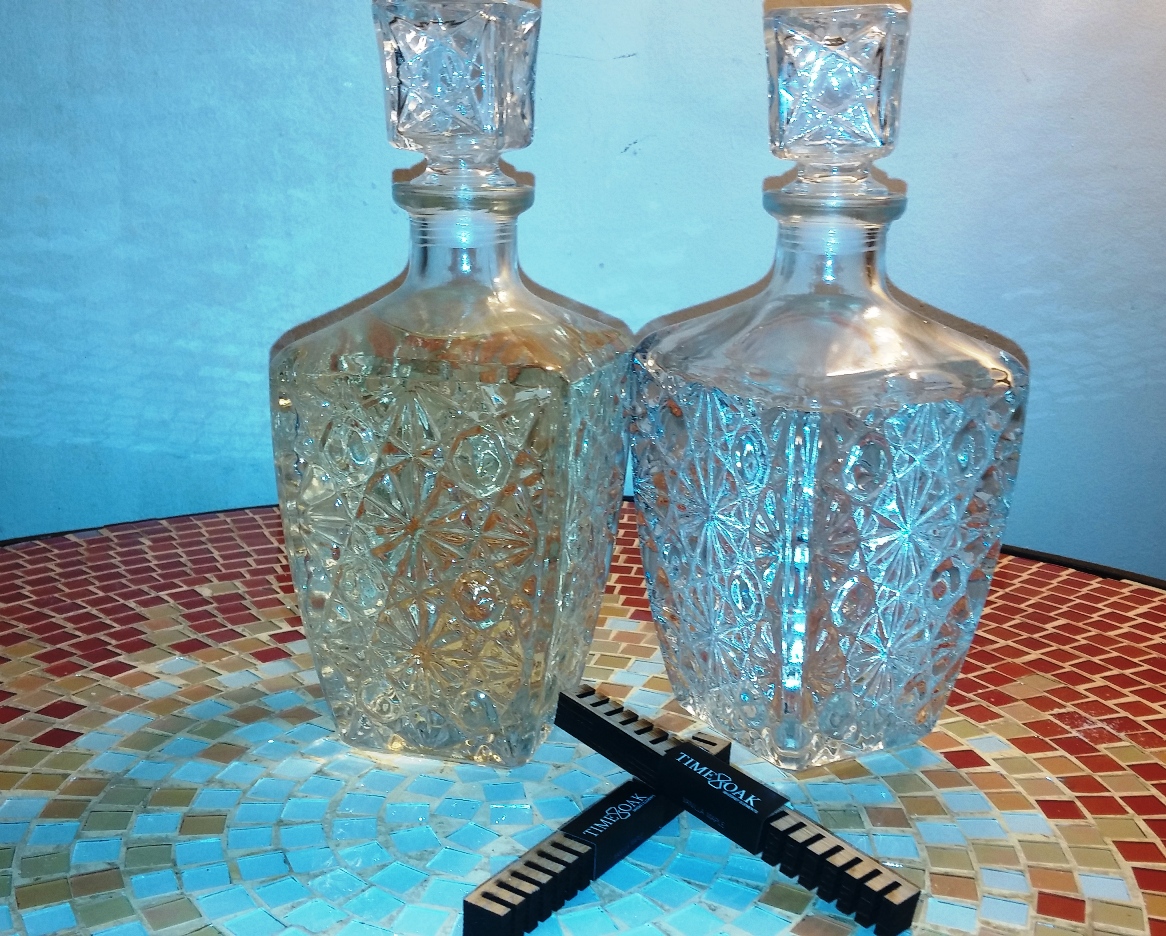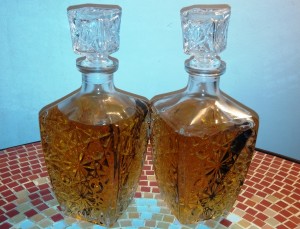Whiskey Elements Review & Trial:
When a friend first told me about the Whiskey Elements Kickstarter last year, I was both intrigued and skeptical. Their one line hook reads:
Customize your whiskey in 24hrs. It’s your whiskey, drink it the way you want. ‘Accelerated transpiration through capillary action.’
Essentially, the Time and Oak team carefully designed and fine-tuned pieces of wood which they say provide “3 years of aging ‘effects’ (time travel not included) in just 24 hours.” They do not add artificial flavoring, despite offering “flavors” of their Whiskey Elements based on different heating and charring techniques.
So, how does it work? Here’s their explanation:
We designed this product to take advantage of transpiration through capillary action that provided a shorter distance for whiskey to travel through its repetitive exposure to the capillaries by cutting it horizontally… In a way, we redesigned the whiskey barrel by removing the barrel and developing a propriatary [sic] curing method to replace its presence in the aging process.
This video goes into more depth, if you’re interested:
Playing with Aging
Time and Oak certainly isn’t the first to try something like this. However, the experimentation is usually done by the distiller, or by a finisher who buys somebody else’s whiskey and attempts to make it their own before putting it on retail shelves.
For example, I reviewed Defiant American Malt Whiskey last year, and was quite pleased with their product. They take spiral cuts of toasted American white oak, and put those straight into the barrel to slash aging time.
In this example and most others I’ve come across, the basic principles do indeed work. Still, many in the whiskey community find it to be gimmicky at best, and a poor replacement for hard time served, year after year, in full-sized 53-gallon barrels. While I’m a bit torn, my overall opinion on this matter is that good whiskey is good whiskey. If the price is right, and you’re honest about what you’re doing, then I won’t hold too much against you. The most important question is – do I enjoy drinking your product?
Back to Whiskey Elements, I am not one to leave this question unanswered. I decided to participate in their — overwhelmingly popular, it raised nearly $200k — Kickstarter campaign and purchase myself a few Whiskey Elements. Let’s give ’em a try.
Designing The Whiskey Elements Test
Time and Oak states that the majority of the effects will be seen in 24-48 hours, and the ideal time is anywhere between one and 10 days. I settled on a week-long trial, and planned on doing taste tests on Day 1, Day 3 and Day 7.
For this highly scientific venture, I would be using two white whiskeys. My first choice was Jim Beam Jacob’s Ghost White Whiskey, likely available at your local liquor store for about $20. This is something that most of you should be able to find and replicate. Second was an unaged white whiskey I’ve had sitting on my shelf collecting dust for several years. Why this one?
Because I can’t stand the stuff. And if you know me, then you know that a whiskey bottle sitting on my shelf untouched for several years is a rare occurrence indeed. (While I’ll refrain from bashing them in text, referring to them only as “Sample B”, if you’re a real sleuth, you can simply view the photos below for the mystery whiskey in question. You can also check out more of my thoughts on white whiskey in general & this particular unnamed product).
Keep in mind, this is not how Time and Oak actually suggests you to use their product. They suggest using “mid-shelf whiskeys”, and go on to say that they enjoy using it with bottles such as “Bulleit Bourbon, Crown Royal, Dry Fly, and Jack Daniel’s.”
But I already like Bulleit Bourbon, Crown Royal, Dry Fly and Jack Daniel’s. I really don’t need to tinker around with them. In order to truly see how much of a difference Whiskey Elements makes, I think it’s far more important to see how much it can improve something you otherwise wouldn’t necessarily enjoy than it is to mess with a proven commodity.
Further, they are claiming three years of aging effects in 24 hours. So why not start with minimally aged juice to see what happens? In the case of Jacob’s Ghost, the stuff is aged for one year, and in the case of “Sample B”, it’s entirely unaged.
The Whiskey Elements Trial – Day by Day Photos & Results
First, you can see the Jacob’s Ghost already has a slight yellow tinge to it from its one year of aging. Sample B, on the right of each photo, is clear. I poured the whiskeys into decanters to offer easy comparisons of color and composition.
I needed to take an initial taste before inserting the Whiskey Elements so I had a true starting point.
- Jacob’s Ghost Tasting Notes: Butterscotch and popcorn on the nose. Actually impressed. A bit fruity, and surprisingly sweet smelling. On the palate, intense grain, hot, and burning. Astringent. The nose is promise unfulfilled.
- Sample B Tasting Notes: Like I said, I hate this stuff. It smells of plastic-jug frat house grade tequila. Tastes like bad memories and poor decisions.
Ultimately, I wouldn’t drink either of these neat for actual enjoyment. In go the Whiskey Elements!
Just 3 Hours In
 I was shocked to check on the two whiskeys just a few short hours later and see a huge difference in color. You could see the golden-copper coloration seeping out of the wood, and stirring the bottle around dispersed it more evenly.
I was shocked to check on the two whiskeys just a few short hours later and see a huge difference in color. You could see the golden-copper coloration seeping out of the wood, and stirring the bottle around dispersed it more evenly.
Morning After
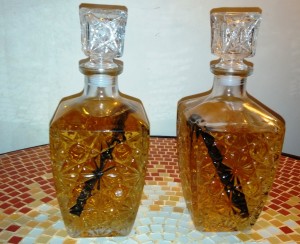 The next morning, each was a deeper, darker brown. Although there was not as much more color as I thought after seeing the whiskeys after just a few hours. It’s been roughly 12 hours at this point, and I still haven’t tasted either, choosing to wait for a full 24 hours to elapse.
The next morning, each was a deeper, darker brown. Although there was not as much more color as I thought after seeing the whiskeys after just a few hours. It’s been roughly 12 hours at this point, and I still haven’t tasted either, choosing to wait for a full 24 hours to elapse.
24 Hours – First Taste Test
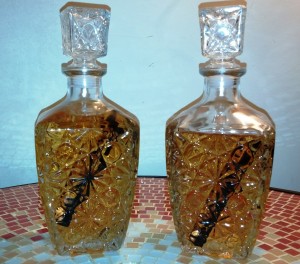 Time for the Day 1 test. It’s exactly 24 hours since I dropped the Whiskey Elements. I think at this point the color has already stopped changing, most of the effects there were really seen in the first 12 hours, as shown above. But how do they actually taste?
Time for the Day 1 test. It’s exactly 24 hours since I dropped the Whiskey Elements. I think at this point the color has already stopped changing, most of the effects there were really seen in the first 12 hours, as shown above. But how do they actually taste?
- Jacob’s Ghost: On the nose I’m getting brown sugar, maple, molasses… and pineapple. On the palate, the intensity and heat from the initial test are largely gone. Pretty impressive. There’s a touch of sweetness, a grainy profile. More palatable and easier to drink, with a short, warming finish. Obviously not great stuff, but a marked improvement.
- Sample B: The nose is still pretty bad here. Maybe slightly less repulsive. On the palate, there’s some oak added to the mix, light hints of caramel, and a less-trashy profile.
Three Days
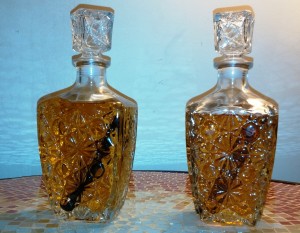 Each whiskey does showcase a fuller brown after several days. This photo is actually from 48 hours, and I didn’t see any real change in coloration after that.
Each whiskey does showcase a fuller brown after several days. This photo is actually from 48 hours, and I didn’t see any real change in coloration after that.
- Jacob’s Ghost: The nose is fruitier. A little floral. On the palate, more caramel in the background. A bit of a syrupy flavor. Surprised that there’s actually a sharper finish than there was after Day 1. Some of the positive changes seem to have been lost, overall, a bit of regression here.
- Sample B: Still a bad-tequila aroma on the nose. Taste is, unfortunately, still cringe worthy.
One Week
- Jacob’s Ghost: The nose offers hints of maple and brown sugar. On the palate, predominately caramel and grain. Overall, smoother after a week than after three days. Somewhat of a rich-syrupy mouthfeel.
- Sample B: Sigh. This stuff is just destined to stay what it is, I suppose. A bit smoother overall but more or less the same.
Conclusion
My biggest takeaway is that what you start with is what you’re going to get. It matters greatly what you use your Whiskey Elements with — they don’t work magic.
The bad stuff improved slightly, but is still pretty bad. Jacob’s Ghost began to see some very positive results, regressed a bit, and ultimately ended with an overall richer, smoother profile. I’ll use the Jacob’s Ghost in cocktails, although Sample B is likely going straight to the back of the bar to continue its prior life of dust collection.
I enjoyed using Whiskey Elements and conducting this little experiment. I think a few friends or whomever else could have plenty of fun and spark some interesting conversation as they tried these out over a weekend.
Does it really provide three years of aging in 24 hours? No, I don’t think it lives up to that claim. Does it add “aging effects” of some kind? Sure.
The bottom line is that I wouldn’t recommend using it with the intention of improving a whiskey you don’t like, or truly elevating a whiskey you already enjoy to a much higher level. But for sheer experimentation? Why not.
UPDATE–
An addendum from the friend who first told me of Whiskey Elements:
It definitely made the Bell’s palatable. Not sure it was the same as a good old whiskey though, definitely worth it for keeping a bottle of house whiskey for guests and some random drinking.
After two weeks, it tastes better than after 36 hours, but still not amazing. I would share it with people not familiar with great whiskey. The bells was £11 (about $17).

